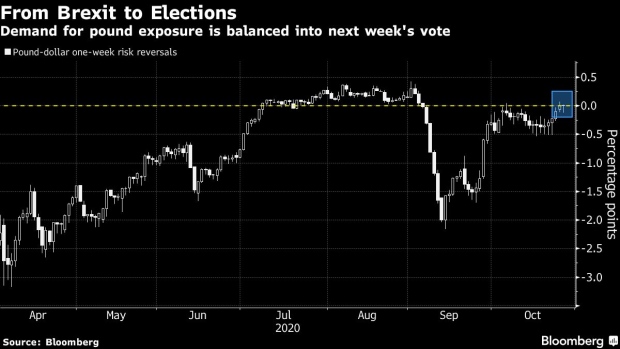Oct 27, 2020
Pound Outlook Clears Before U.S. Vote But Gains Depend on Brexit
, Bloomberg News

(Bloomberg) -- The pound looks poised for gains ahead of U.S elections, yet whether it can maintain momentum after the vote is still questionable.
Option risk reversals show traders are no longer bearish the U.K. currency over a one-week horizon, opening the way for an advance before the Nov. 3 vote in America. Behind the shift in this gauge of positioning and sentiment lies the latest progress in Brexit negotiations, and a bias in the market to sell the dollar in the run-up to the election.
Whether the currency manages to hit fresh highs or sustain gains thereafter, however, still depends largely on how negotiations between the U.K and the European Union pan out. The market’s overall risk appetite given uncertainty surrounding the pandemic will also prove key.
The pound drifted against the dollar on Tuesday, after bouncing back from the psychologically important $1.30 handle early in the session. According to traders in Europe, leveraged funds were fading the move lower, with institutional investors looking to add topside sterling exposure in the options space.
Charts are also working in cable’s favor. The currency remains within a bullish trend channel in both the short and medium term. Meanwhile, momentum gauges such as Bloomberg’s fear-and-greed indicator show bulls remain in control of price action.
But caution is still warranted. Sterling reached a six-week high of $1.3177 on Oct. 21, only to falter again as profit taking kicked in. Corporate selling on a hedging basis has also been a key element in this pullback, according to a trader in Europe familiar with the transactions who asked not to be identified because he is not authorized to speak publicly.
And the outlook further out into the future still remains murky. One-month risk-reversals remain in bearish territory for sterling as investors look for an official resolution in Brexit talks before turning bullish in the longer-term too.
According to Bloomberg’s option-pricing model, the chances of the pound trading 5% higher in six months time are slightly higher than the probability of an equivalent drop.
- NOTE: Vassilis Karamanis is an FX and rates strategist who writes for Bloomberg. The observations he makes are his own and are not intended as investment advice
©2020 Bloomberg L.P.





